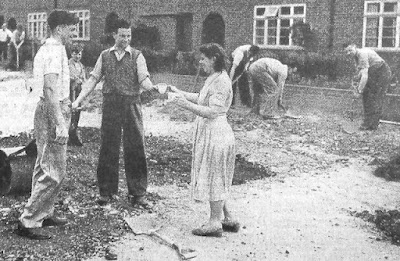All such streets were considered private, owned jointly by its occupiers or landlords, until such time as the council had sufficient funds to carry out the work with a good chance of being recompensed through special loan schemes; the sums involved were not inconsiderable. In the meantime, residents put up with the inconvenience of dust, mud and potholes, sometimes for several years. The photo of a community group from Woodland Drive agreeing to carry out some of the more serious work was not unusual; it was, after all their road.
When residential development took place without regard to overall responsibility for drainage, adding more and more buildings and hard surfaces also added flooding risk. Between the northern and southern halves of previously Spencer-owned land lies Brampton Road and its downhill gradient from the park end to Woodstock Road. Before the houses went up surface water in periods of heavy rainfall would have found its way towards the former ancient stream bed just east of the Woodstock Road homes, eventually finding its way to the Ver, the Colne and the Thames.
 |
| Hamilton Road today COURTESY GOOGLE EARTH |
In fact so long did the Hamilton Road residents have to wait that the earliest had lived there for over twenty-five years; by which time the road had been torn up to lay larger drainage pipes all the way to Campfield Road.
Since the road was their pride the householders agreed to purchase a few small street trees. An early attempt to take the same approach to paying for street lights [the editor knows what it was like growing up in a dark estate devoid of lighting] was more difficult to resolve, since the largest cost was in laying the cables, so a start was made from a connection from Jennings and Brampton roads; the long middle section was still dark!
 |
| A Sunday morning road mending session; Woodland Drive north in the early 1950s COURTESY HERTS ADVERTISER |
Today, house builders have to do more than build homes; they must comply with standards set by regulatory bodies and local authorities, and carry out road construction, public lighting, cycle and pedestrian routes, and of course community open space, before the council signs off the development and agrees to adopt the road(s), street plates included. Aren't we lucky? Maybe, but that's what we have paid for. People today moving into Osprey Drive and Austen Way won't be enduring the same fun as those from Royston Road, Meadow Close and Hamilton Road in their time.

No comments:
Post a Comment